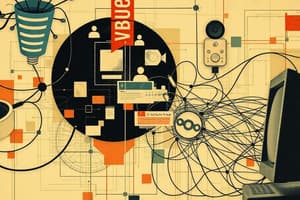Podcast
Questions and Answers
What is a computer network?
What is a computer network?
A computer network is two or more computers that are connected via software and hardware to communicate with each other.
Which of the following are benefits of computer networks? (Select all that apply)
Which of the following are benefits of computer networks? (Select all that apply)
- Sharing files (correct)
- Common communications across different operating systems (correct)
- Sharing an Internet connection (correct)
- Enhanced gaming experience
What is a major disadvantage of networks?
What is a major disadvantage of networks?
- Requires multiple devices
- High maintenance costs
- Difficult to manage
- Setup time (correct)
What is the difference between data transfer rate and throughput?
What is the difference between data transfer rate and throughput?
What are the types of transmission media used in networks?
What are the types of transmission media used in networks?
Which statement about a client/server network is true?
Which statement about a client/server network is true?
Which is NOT a standard wired broadband technology?
Which is NOT a standard wired broadband technology?
What do you need to access the Internet wirelessly at home?
What do you need to access the Internet wirelessly at home?
Match the following types of networks with their definitions:
Match the following types of networks with their definitions:
What should be considered before creating a home network?
What should be considered before creating a home network?
To extend the range of Wi-Fi, one option is to use a wireless ______ to amplify the signal.
To extend the range of Wi-Fi, one option is to use a wireless ______ to amplify the signal.
Broadband is the same as dial-up Internet access.
Broadband is the same as dial-up Internet access.
What is one method to secure your wireless network?
What is one method to secure your wireless network?
How far can Wi-Fi 4 or Wi-Fi 5 wireless devices typically reach?
How far can Wi-Fi 4 or Wi-Fi 5 wireless devices typically reach?
Which type of network is specifically designed for communication among devices close to one person?
Which type of network is specifically designed for communication among devices close to one person?
What does the term 'throughput' refer to in the context of networks?
What does the term 'throughput' refer to in the context of networks?
Which of the following is a disadvantage of computer networks?
Which of the following is a disadvantage of computer networks?
What role does a server play in a client/server network?
What role does a server play in a client/server network?
In network classification, which network type covers a larger geographical area than a Local Area Network (LAN)?
In network classification, which network type covers a larger geographical area than a Local Area Network (LAN)?
What is one of the primary advantages of connecting computers in a network?
What is one of the primary advantages of connecting computers in a network?
Which of the following best describes a peer-to-peer (P2P) network?
Which of the following best describes a peer-to-peer (P2P) network?
What is the primary purpose of a router in a network?
What is the primary purpose of a router in a network?
Which type of cable uses twisted copper wires for transmission?
Which type of cable uses twisted copper wires for transmission?
What is necessary for a network to function effectively?
What is necessary for a network to function effectively?
Flashcards
Computer Network
Computer Network
Two or more computers connected via hardware and software to communicate.
Node
Node
Any device connected to a network (computer, printer, router).
Network Benefits
Network Benefits
Sharing internet, printers, files, and communication between different OSs.
Data Transfer Rate
Data Transfer Rate
Signup and view all the flashcards
Throughput
Throughput
Signup and view all the flashcards
LAN
LAN
Signup and view all the flashcards
Client/Server Network
Client/Server Network
Signup and view all the flashcards
P2P Network
P2P Network
Signup and view all the flashcards
Ethernet
Ethernet
Signup and view all the flashcards
Transmission Media
Transmission Media
Signup and view all the flashcards
UTP cable
UTP cable
Signup and view all the flashcards
Broadband Internet
Broadband Internet
Signup and view all the flashcards
Wireless Access
Wireless Access
Signup and view all the flashcards
Wireless Security
Wireless Security
Signup and view all the flashcards
Router
Router
Signup and view all the flashcards
Network Node
Network Node
Signup and view all the flashcards
Data Transfer Rate
Data Transfer Rate
Signup and view all the flashcards
Local Area Network (LAN)
Local Area Network (LAN)
Signup and view all the flashcards
Network Benefit: Sharing
Network Benefit: Sharing
Signup and view all the flashcards
Throughput
Throughput
Signup and view all the flashcards
WAN
WAN
Signup and view all the flashcards
Client/Server Network
Client/Server Network
Signup and view all the flashcards
P2P Network
P2P Network
Signup and view all the flashcards
Ethernet
Ethernet
Signup and view all the flashcards
Network Adapter
Network Adapter
Signup and view all the flashcards
Study Notes
Chapter 7: Networking: Connecting Computing Devices
- This chapter covers networking concepts, including the pros and cons of computer networks, different network types, transmission media, necessary hardware and software, and broadband internet access options.
- Learning objectives include describing computer networks and their pros and cons, explaining different network definitions, describing transmission media types, hardware for networks, network software types, and summarizing broadband internet access options. -Additional objectives involve wireless internet access, home network setup considerations, problems with wireless networks and solutions, and securing wireless home networks.
Networking Fundamentals
- A computer network connects two or more computers for communication using software and hardware.
- Each device on a network is a node, including computers, peripherals (printers, game consoles), and network devices (routers).
- Benefits of networks include sharing a high-speed internet connection, printers and other devices, files, and communication.
- The main disadvantage of networks is setup time.
Network Architectures
- Networks are classified by distance:
- Personal Area Network (PAN): Communication among devices close to one person.
- Local Area Network (LAN): Devices located in a small geographical area.
- Home Area Network (HAN): LAN within a home.
- Metropolitan Area Network (MAN): Large network serving a city.
- Wide Area Network (WAN): Spans a large physical distance.
- Networks can also be classified by administration level:
- Client/Server Network: Clients request information from a central server.
- Peer-to-Peer (P2P) Network: Each node can communicate directly with others.
- Networks are also classified by protocol:
- Ethernet: A network protocol developed by the Institute of Electrical and Electronics Engineers (IEEE).
- Wireless networks (Wi-Fi)
- Wired networks (Gigabit Ethernet [GbE])
- Backward compatibility: the ability of current devices to use earlier standards
Network Components
- Network components include:
- Means of connection (cables or wireless technology).
- Hardware devices for communication and data transfer.
- Software to run the network.
- Network adapter/ NIC (provides network connectivity)
- Modems (for broadband connections)
- Routers (for transferring data between networks)
- Switches ( for managing data flow on a network).
Transmission Media
- Transmission media establishes a communication channel between network nodes, either wireless or wired.
- Wired media includes UTP cable (twisted copper wires), coaxial cable (single copper wire), and fiber-optic cable (plastic or glass fibers).
Network Software
- Operating systems support peer-to-peer (P2P) networks.
- Client/server networks use specialized network operating systems (NOS) for centralized servers.
Connecting to the Internet
- Broadband is the preferred internet access method.
- Broadband types include cable, DSL, and fiber-optic service.
- Wireless internet access methods include mobile broadband, wireless internet at home, mobile hotspots, wireless ISPs, and data plans.
Installing and Configuring Home Networks
- Planning considerations include listing connected devices and using the latest networking standards and equipment.
- Specialized home networking devices include network-attached storage (NAS) devices, home network servers, and network-ready devices.
- Routers and switches are used to manage data flow and connectivity.
Troubleshooting Wireless Networks
- Maximum Wi-Fi range is limited, and walls/metal objects can create interference.
- Placing access points where the signal is weak can help.
- Wireless extenders repeat/amplify router signals.
Managing Wireless Networks
- Use encryption and security protocols.
- Change the network name (SSID)
- Disable SSID broadcast.
- Change the default password
- Creating a passphrase
- Limit signal ranges
- Implementing media access control
- Keeping router firmware updated
- Disabling remote access
Studying That Suits You
Use AI to generate personalized quizzes and flashcards to suit your learning preferences.




